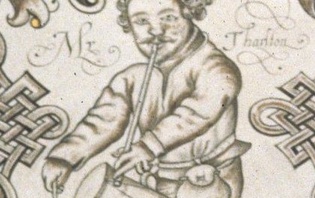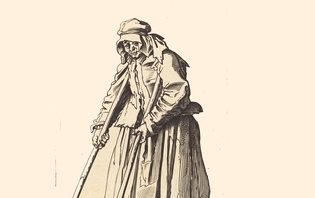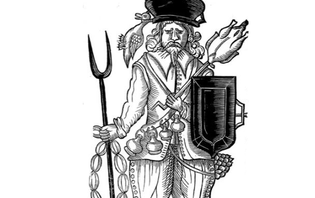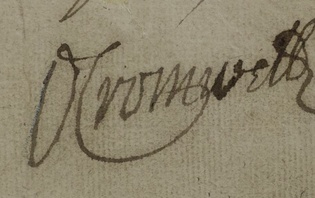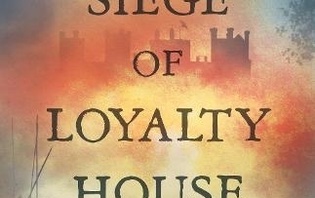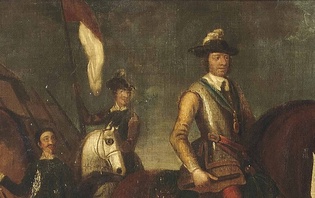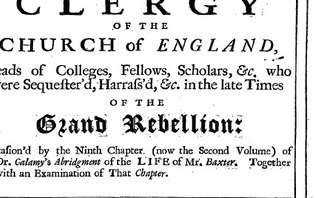‘Your petitioner having much suffered’ – Petitioners to the Court of Wards during the British Civil Wars
For families, the impact of loss of life during the British Civil Wars often went beyond the emotional and financial. For those who held land as tenants-in-chief of the King, there was the added burden of wardship and the legal processes and expense that it incurred. Widows whose husbands had been slain in battle now had to face a contest of their own as they fought to keep the custody of their children and protect their inheritance against competitors who saw financial profit in obtaining the wardship for themselves. Between 1642 and 1646 this burden was often exacerbated by rivalries within families induced by the conflict. It was also affected by the increased complexity of the legal processes as the Court split, with rival courts at Oxford (for the King) and Westminster (for Parliament). In this blog, Diane Strange uses petitions to the Court of Wards to investigate some of the problems faced by its litigants, as well as how the Wars affected the running of the Court and contributed to its demise in 1646.

William Fiennes, first Viscount Saye and Sele, Master of the Court of Wards from 1641 (image copyright The Fairclough Collection, University of Leicester, reproduced under a CC BY-NC licence).
On 19 November 1645 a petition arrived in front of Viscount Saye and Sele, master of the Court of Wards and Liveries in London. It came from Elizabeth Dawnay, widow of John Dawnay of Cowick, Yorkshire, and daughter of Sir Richard Hutton, the common-law judge who opposed Ship Money during the Personal Rule. Elizabeth explained that her ‘late brother’, the second Sir Richard Hutton, had died about twenty days previously, ‘seized of diuers Mannors and lands in the Countie of York … leaueing his son & heire within age & in warde to his Ma[jes]tie’. As Ronald Hutton relates in his blog post Meet a magistrate, Sir Richard had fought valiantly for the King up to his death in battle at Sherburn-in-Elmet on 15 October 1645. The object of Elizabeth’s petition was the third Richard Hutton, Sir Richard’s son who, we are glad to learn from Ronald Hutton, survived the war and its aftermath and at last ‘lived out … his days in peace.’
As Elizabeth went on rather breathlessly to explain, she had learned that Sir John Savile, a distant relative of the ward, had petitioned the Court already for young Richard’s wardship, ‘upon some p[re]tence of Alliance to the ward’. With a strength of will of which we hope her father would have been proud, Elizabeth asked for a supersedeas, a writ that would override Savile’s suit, and for permission to pursue the wardship herself, effectively ousting Savile from the case [TNA WARD 10/39part1]. Such competitions were common, since wardships could be lucrative and offered inviting scope for playing out feuds and family rivalries through the battle for the child – or children, where there were female coheirs. But this case had uncomfortable undertones. For whereas Hutton had died fighting for the Royalists, Savile was a Parliamentarian colonel in the northern army under Ferdinando Lord Fairfax. This, then, was a war within a war: the battle for custody of Richard and his estate between adherents to rival sides. Nevertheless, as Elizabeth had rushed her petition into Court just within the month allowed to relatives to prioritise their claim over other potential guardians, the staunchly Parliamentarian Saye authorised the supersedeas (perhaps with a sigh) and granted Elizabeth the writ that she sought.
Elizabeth Dawnay’s anxious petition is just one of thousands to the Court that survive in The National Archives at Kew. They originate from all sorts of people, from nobility boasting thousands of acres of land, through the gentry, and down to the poorer sort with just a small tenement an acre or two worth no more than a few pence per annum. Almost all of them held their land from the king ‘in capite by knights service’, meaning that if upon the death of the tenant the heir was a minor – 21 for a boy, 14 for a girl – they were liable for a wardship, which embarked their family on a prolonged and costly legal process. ‘Knights service’ had once meant fighting for the king in defence of the kingdom in return for the grant of royal land. If the tenant was a minor, then they became a ‘ward of court’ until they came of age, giving the Crown the right to their marriage and the lease of their lands. The custom of obligatory military service was long defunct by the seventeenth century; instead, recompense for living on the royal demesne took the form of a fine, levied through the sale of ‘the wardship of the body and lands’ as the petitions frequently term it, and the right to arrange his or her marriage.
Thankfully, the morality or otherwise of this need not trouble us here. Instead, the focus is on the petitions as historical documents and the shaft of light they shine on the hidden effects of the Civil Wars: the fate of the widows and children of the slain, and their lands.
In its rawest state, a petition to a court of law was a simple initiation of a legal process: it advised the court of the matter at issue and set the business in motion. So Elizabeth Dawney, in common with thousands of petitioners like her, summarised what had happened and then stated, in suitably humble terms, what she desired. In most cases the petitioners were reporting that a death had occurred and that there was a tenure for the king, and they were asking to compound for the wardship of the heir. But hanging on this bare framework is a wealth of detail that gives us fascinating and often illuminating insights into the politics, society, economics and land distribution of the age.
Like Elizabeth Dawnay’s, every petition tells a story. Each has its cast of characters with hopes, prejudices, rivalries or anxieties. A few evince a plot. Sometimes there is a heroine, but rarely is there a hero, and often we encounter a villain. Underpinning each story is a plethora of detail and information about the aspirations and disappointments of an incredibly diverse spread of humanity, and each one is indicative, in some microcosmic form, of what it meant to be human in early modern England. They represent a part of what Diarmaid MacCulloch has termed ‘the flotsam from a host of individual stories of human beings’, unlikely survivals of what over the centuries has been the widespread and often unwitting destruction of a morass of manuscript material. Individually, each petition contributes to a corner of historical knowledge; en masse, they help to emphasise how deeply embedded wardship was in early modern law, society and economy, and offer intriguing hints at why the wardship system escaped abolition for so long.
The British Civil Wars witnessed the twilight and final closure of the Court, and as the petitions illustrate, the problems of wardship and the covetousness of the officials who perpetuated it, set down in The Grand Remonstrance of 1641, were exacerbated by the pressures of war and the rivalry that ensued as both sides fought for control. In a royal proclamation dated 27 December 1642, and much to Parliament’s chagrin, the King announced the removal of the Court of Wards to Oxford. Unyielding despite Parliament’s petition to let it remain at Westminster, Charles ordered its personnel to move with him, including Saye, who had replaced Lord Cottington as master during the King’s reshuffle of offices in April 1641. Not all were obedient to Charles’s will. Twelve Court officers refused the move, as did two local officials: ‘Geruase ffeodary of South[amp]ton’, and Thomas Goodyere, the feodary of Gloucestershire, denounced in a strong hand as ‘an Arch Rebell’. [BL Egerton 2978, f. 76]. Unsurprisingly Saye too refused to accompany Charles, and by order of the Lords remained at Westminster. Thus there was a ‘curious paradox’ as historian of the Court H.E. Bell wrote, ‘when the men who had consistently opposed wardship and livery themselves maintained their own Court of Wards and Liveries’. What previously few on either side had wanted, now both sides wanted: control of the wardship machine.
Petitioners to the Court of Wards now faced a choice. Did they start process through the King’s Court, or Parliament’s? For many, it would have been an obvious choice; for others it would have been a traumatic decision. The fate of their children, their lands, their finances and their lineage might rest on the outcome. Insights into how people made that choice are still hazy. Few petitions to the Oxford Court have yet emerged, so it is not possible to compare the operation of the Courts through their petitioners or to determine how individuals made their choices. Logically, Royalists would be expected to petition the Oxford Court, with Parliamentarians petitioning Westminster. Yet the evidence suggests it was not that clear cut. Elizabeth Dawnay petitioned Lord Saye despite her royalism, but as Sir John Savile had initiated the business through the Westminster Court she might have felt obliged to pursue that course. What the petitions suggest, however, is that some Royalists petitioned the Westminster Court voluntarily. Dame Elizabeth Hewett petitioned in 1644 for the wardship of her grandson, 17-year-old Thomas Richardson, the son of Lord Chief Justice Sir Thomas Richardson, a Royalist supporter who died in prison in Norwich in 1644. Also in 1644, Richard Foxley petitioned for the wardship of Newdigate Poyntz’s son; Poyntz was killed while fighting for the King at the battle of Gainsborough, which took place on 28 July 1643. We also find Lady Anne Harcourt petitioning the Court on 30 December 1645. Lady Anne was the widow of the Royalist Sir Simon Harcourt, who died fighting Irish rebels three years earlier, in 1642 [WARD 10/42part2]. It is nonetheless noteworthy that Lady Anne was still seeking a writ in 1645, three years after her husband’s death. Lady Anne’s case may suggest that Saye was unwilling to prioritise the suit of someone who had been shown open favour by the King. Charles had lauded Sir Simon for his service in Ireland following news of his death and had rewarded him posthumously: ‘after “much bewayling the losse” of Sir Simon, the King granted the forfeited lands and castle where Sir Simon had fallen to Harcourt’s widow and children.’ Saye, perhaps, felt little incentive to assist the widow of a fêted Royalist.

Francis, Lord Cottington, Master of the Court of Wards 1635-41 (image copyright the Fairclough Collection, University of Leicester, reproduced under a CC BY-NC licence).
Royalists might have made this choice because they found it hard to break with legal tradition or because they doubted the credentials of the breakaway Court. Or possibly the long-established Westminster Court was deemed to function more effectively than its Oxford rival. Bell, who has conducted some of the only research into the bifurcated nature of Court during the Civil Wars, was left with the impression ‘that the scope of the Oxford Court was limited’. Did any cases where there were rival competitors to the wardship, such as that of Elizabeth Dawney and Sir John Savile, involve petitions to both Courts, with rival claimants in each? It seems likely: but so far the evidence is lacking. What can be suggested, however, is that the Oxford Court was less well organised than the Westminster Court, not least because it lacked its Master. In the early months of the conflict Cottington was lying low at his house in Fonthill Gifford, Wiltshire, and did not join the King at Oxford until April 1643. In his absence, petitions were being handled by Charles’s secretary Sir Edward Walker, and by Richard Chamberlain, clerk of the Court, and some at least were overseen by Charles himself. [BL Egerton 2978, f. 87]
The problems of running a court in wartime were not limited to Oxford. During the 1640s the Court began to witness a rapid rise in a form of petition rarely seen in earlier decades: prompts for the Master to appoint a date for a hearing. A slackening of business due to the difficulties of the times is evident from mid-1642. Margery Caesar, the guardian of John Caesar, a ward, petitioned on 15 June 1642 asking for a hearing; a month later, Roger Bodenham saw fit to reminded the Court that the depositions relating to his case had been published, ‘and the Cause [is] ready for hearing as by y[ou]r ord[e]r hereunto annexed may appear’. The widow Jane Dockwray, a defendant, also petitioned in 1642 asking for a hearing, reminding Saye that the case was ‘Ripe for yo[u]r Lor[dshi]pps Judgm[en]t’ [WARD 10/42part2]. Many more petitions tell a similar story of cases delayed or postponed and suggest that even before the split, the Court was experiencing difficulties in coping as the crisis unfolded.
As the conflict developed, petitioners also found it difficult to pursue their cases due to the upheavals of war. Elizabeth Bewicke first petitioned for the wardship of her son in April 1642. She petitioned again in June, pleading for further time to find the office because of the absence of the necessary commissioners ‘beinge att London aboute business in parliam[ent]’. ‘The great destracc[i]ons of the times’ prevented Elizabeth Spitty from prosecuting her case in May 1644, while due to the plunder of Sir Edward Peyto’s house and the removal of the evidences late in 1645, Devereaux Peyto and James Prescott were hampered in their wardship bid. They, too, sought a grant of further time [WARD 10/39part1].
What many of these petitioners never got was any form of closure. Neither Elizabeth Dawnay nor Sir John Savile nor the persistent Dame Anne Harcourt could expect an official resolution to their fights, as the Court of Wards was formally abolished by the Long Parliament on 24 February 1646. In the following July the royal seal was brought from Oxford to London and broken. For many, the abolition came not a day too soon. Feudal tenures had long been thought on as an anachronism, a relic of dead times, an uncomfortable survival of pre-Reformation ideologies and honour values that had no place in the sensitive Protestant milieu of early modern England and Wales. Men no longer performed military service in return for land; family values were changing and the child was deemed to belong with the mother in the family home, not to be farmed out at the Court’s discretion. Feudal tenures had become an exploitative system of revenue generation, a tax on land – and no one loves a tax. Speaking at a conference of the Lords and Commons back in March 1610, the Earl of Salisbury had expressed the importance of wardship to the king in a rather strained metaphor, volunteering that it was ‘not a leaf but a bough and arm of … a great tree in his garland’. Now the great limb had been struck from the royal garland and few were sorry to see it go. Especially glad, no doubt, were the thousands of petitioners for whom the stress of wardship and its associated litigation had been added to the tragedy and loss inflicted on them by the British Civil Wars.
Further Reading
E. Bell, An introduction to the history and records of the Court of Wards & Liveries (Cambridge: Cambridge University Press, 1953), pp. 150–153.
Richard Cust, Charles I and the aristocracy, 1625–1642 (Cambridge: Cambridge University Press, 2013), p. 232.
Mark Charles Fissell, English Warfare, 1511–1642, 2nd edition (Oxford: Routledge, 2016 [First edition 1991]), p. 281.
Elizabeth Read Foster (ed.), Proceedings in Parliament 1610, Vol. I: House of Lords (New Haven and London: Yale University Press, 1966), p. 25.
Martin J. Havran, Caroline courtier: the life of Lord Cottington, (London: Macmillan, 1973), p. 159.
Diarmaid MacCulloch, A history of Christianity, 2nd edition (London: Penguin, 2010), p. 11.
Diane Strange is an M4C AHRC-funded PhD student at the University of Leicester. Her research focuses on petitions and petitioning strategies to the Court of Wards and Liveries between 1610 and 1645. She is currently developing her research into petitions to the Court of Wards during the British Civil Wars into a journal article, which she hopes to publish in 2021. Diane is the author of ‘From Private Sin to Public Shame: Sir John Digby and the use of Star Chamber in Northamptonshire and Bedfordshire, 1610’, Midland History, Vol. 44, No. 1 (Spring 2019), pp. 39–55, which won the Midland History Essay Prize in 2018. She is also the co-editor of the brochure for ‘The World Turned Upside Down’ exhibition at the National Civil War Centre.

